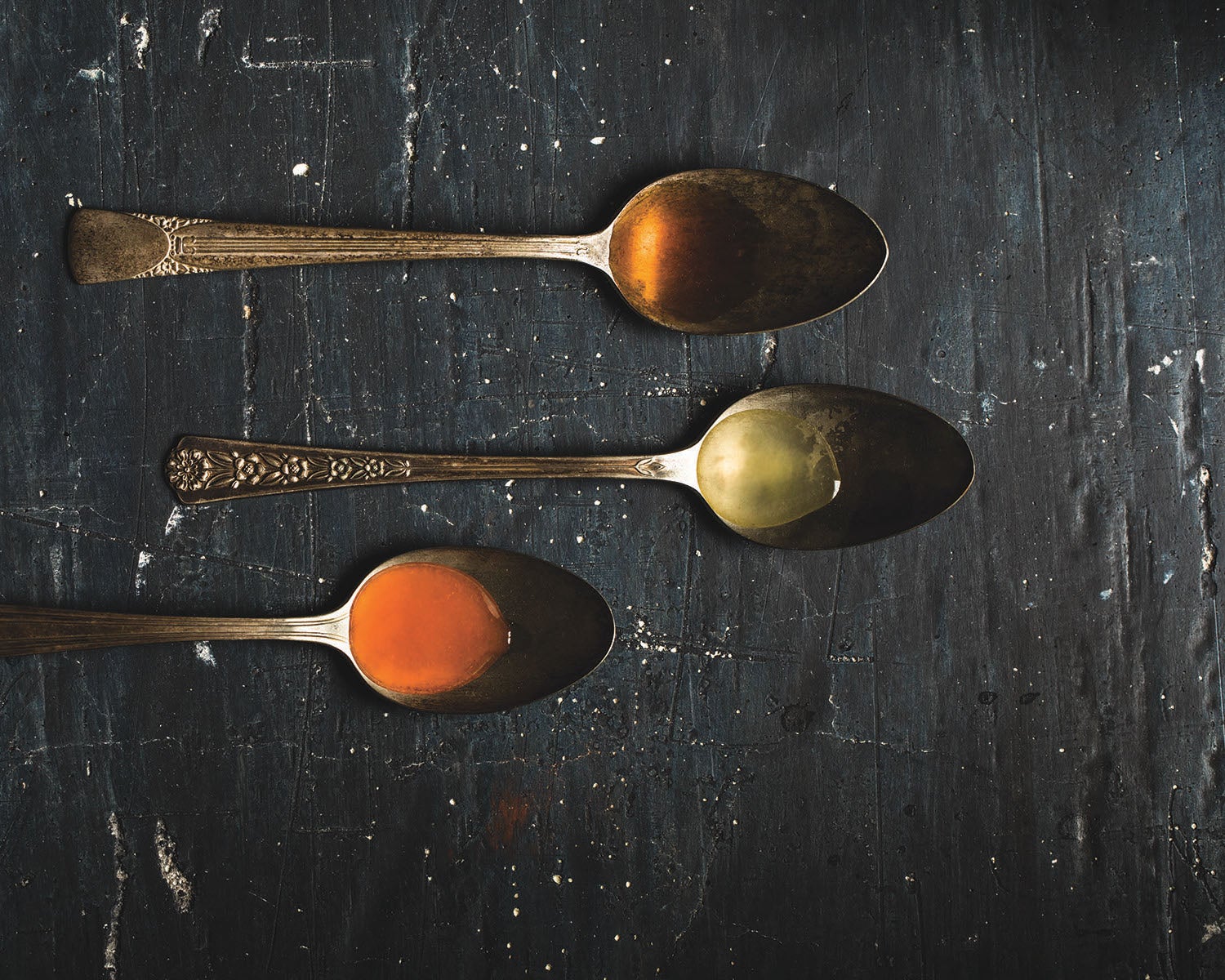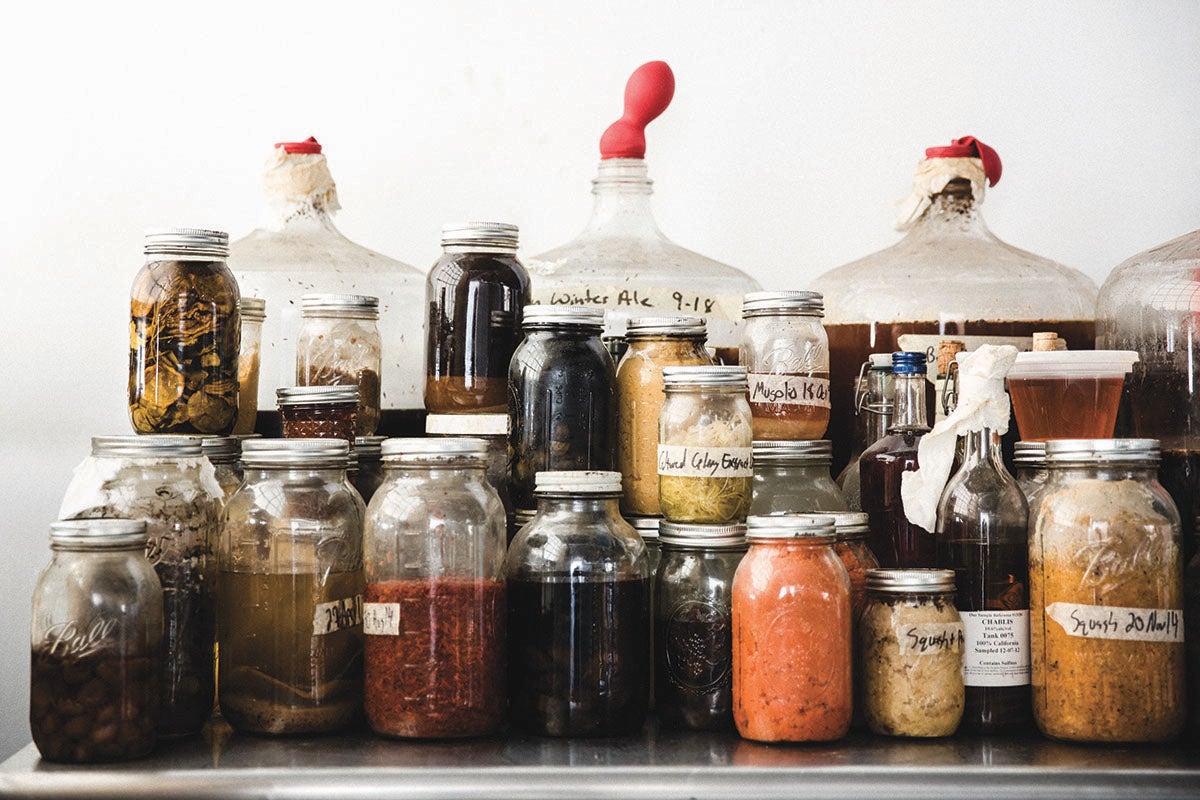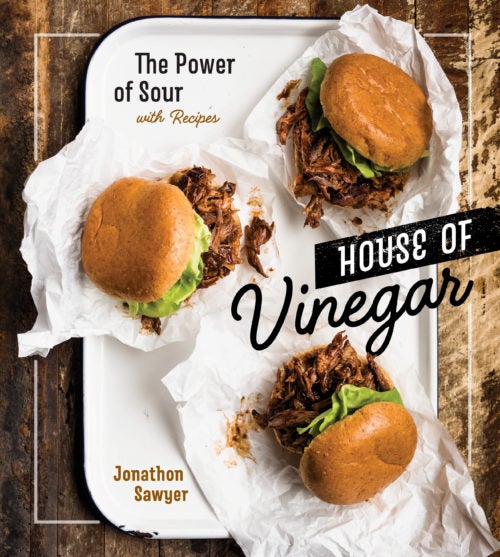Making vinegar is the ideal low-stakes home fermentation for lazy home cooks to experiment with. Is that you?
Here’s what happened the one time I tried to make beer: I emphatically bought all the equipment, sterilized it scrupulously by hand, followed the first few steps, and then placed the six-gallon glass carboy of mush in a closet, where I promptly forgot about it until I had to move out of that apartment. Here’s what happened the time I tried to make my own sourdough starter: I read voraciously about the process, measured out flour meticulously, and then left the gurgling sludge in a corner of the refrigerator until my roommates complained. It goes without saying that I don’t have any pets and all of my plants are dead.
I thought I had come to terms with the fact that I would never be a person who ferments, until I picked up a copy of House of Vinegar, a new acid-centric cookbook by Cleveland chef Jonathon Sawyer. Everything I thought I knew about making vinegar (special equipment, imported oak casks for aging, acquiring a swamp-monster-looking “mother” to kick-start bacterial growth) was thrown out the window. It turned out all I needed was a little beer or wine, a clean jar, and some cheesecloth to let microbes in but keep bugs out. With a half-drunk bottle of Syrah left over from a recent dinner party, the stakes were exceedingly low.
When I’m cooking, I find that a teaspoon of vinegar is often the missing link in a too-salty soup or overly spicy sauce. And as Sawyer explains, it works as a local, shelf-stable alternative to the citrus you might use to punch up a cocktail or finish a fruity dessert. In dishes that you might be inclined to finish with a squeeze of lemon, often a tiny bit of a fruity vinegar works just as well.

“Vinegar—maybe because of its room-temperature-ness, or because of how a mother [the vinegar’s slimy microbial by-product] can look over years—it’s more intimidating. But there’s little that can go wrong,” Sawyer reassures me over the phone. Even if you don’t have pH strips on hand to trace the fermentation’s progress, it’s completely safe to check in on the wine’s progress by tasting. As it ferments, any pathogens that make their way into the liquid will be killed either by the alcohol or by the acidity of the vinegar once the alcohol has transformed. You can keep on aging your vinegar as long as you’d like, whether it’s a couple weeks or a few months, and the flavor will keep developing as the liquid pulls in yeast and bacteria from the air.
Once you’ve graduated from these most basic forms of vinegar-making, you can turn almost anything into vinegar. One recipe in House of Vinegar creates a fermentable, low-alcohol (the ideal ABV for vinegar is between 3 and 15 percent) mixture using scotch, prosciutto, and water. One recipe starts out with cream soda and vanilla schnapps and transforms that sugar and alcohol into a vanilla-scented vinegar that’s great on ice cream.
Aside from wine vinegars—red, white, sherry, or champagne—Sawyer says that beer is a great starting point for someone who’s never made vinegar before, particularly a beer that’s low in hops (since all that bitterness will remain in the final product) but high in sugar and alcohol (which will ferment quickly), like a Belgian dubbel or a malty stout. Even with a minimal amount of effort, essentially cracking open a bottle of ale, covering the top with cheesecloth, and waiting around, you’ll end up with your own unique vinegar.
Two vinegars made with the same method, and even using the same original beer, can taste wildly different depending on the flora and fauna of their environment, explains Sawyer. “So just the fact that you’re making it yourself makes it individual and singular and bespoke just for you.”
After a couple weeks sitting on the countertop in a jar, my leftover wine stopped smelling like leftover wine and started smelling faintly but familiarly like the vinegar I buy in small $8 bottles to sprinkle into skillets of caramelized onions or blend into shallot-y vinaigrettes. Finally, my outstanding ability to abandon and ignore was beginning to pay off.
Turning beer into vinegar is an ancient tradition, but we can thank the British for popularizing it. While most of Europe was focused on making wine and wine vinegars, the British were brewing beer and making beer vinegars. You’re probably familiar with these types of vinegars by their more common name: malt vinegar. You know, the one that you sprinkle on fish and chips. Once I owned my own restaurant, Greenhouse Tavern, which held hundreds of feet of draft lines, it was only natural to begin mass-producing premium craft-beer vinegars. This recipe cemented my sour legacy.
When you begin making this vinegar, you’ll want to keep in mind something important. After you mix everything together and as time goes on, you’ll notice a layer of what looks like gelatin growing on the surface. This is the mother of vinegar. Without it, the alcohol won’t be converted into vinegar.
Make sure to use a beer for this that is 6 to 12 percent alcohol by volume (ABV). And don’t use one that is too hoppy, or your vinegar will be bitter.
- Wash a 1-quart wide-mouth glass container in hot, soapy water, then rinse and dry thoroughly.
- Pour the beer into the container. Stir with a spoon to dissipate the carbonation, and then let sit for 30 minutes. You want the beer to be flat and not fizzy.
- Cover the container's opening with cheesecloth, securing it with a rubber band to keep out debris.
- Let the container sit in a cool, dry, dark place for 2 weeks. Then give the mixture a taste; if it's sharp, tangy, and sour (like other vinegars you've had), it's now vinegar (It's perfectly okay to
taste; no pathogens can survive in either the alcohol or the vinegar.) If you prefer, you can also judge the progress of your vinegar by using pH strips; we shoot for a reading of 4 or below on the pH scale.
Ingredients
- 2 cups sugar
- ¾ cups unsalted butter, at room temperature
- 1 egg, plus 1 egg yolk
- 2½ cups all-purpose flour
- ½ cups cocoa powder
- 1 teaspoon baking soda
- ½ teaspoons kosher salt
- 1½ cups stout or milk stout beer (preferably Mom Jeans from Hoof Hearted Brewing) or bourbon, if you’re feeling randy
- 2 tablespoons Greenhouse Tavern–Style Craft-Beer Vinegar
- 1 teaspoon pure vanilla extract
- Ice cream for serving
- GREENHOUSE TAVERN–STYLE CRAFT-BEER VINEGAR
- Equipment
- 1 quart widemouthed glass container
- large spoon
- Cheesecloth or paper towel
- Rubber band or butcher’s twine
- pH test strips (optional)
- Ingredients
- 4 cups beer
Every year, we host a “Metal as Fuck” dinner at the Greenhouse Tavern. As you can guess, everything we serve at the meal—from the burgers to the dessert—has a certain darkness to it, all of it inspired by the coolest evil crap we can think of. For example, take the backstory behind this vinegar-based cake. In the 1200s, an Italian dark-arts practitioner named Dracosia advised a powerful Genoan family during a war. When he failed to help them, he was prosecuted for practicing black magic and stripped of his name. The new name he and his descendants received was “Boccanegra,” which means “black mouth.”
Apologies for the following corniness, but when we first whipped up the dinner’s chocolaty, boozy cake, I totally fell under its spell. And that’s not even the best part about the cake; every single bite an attendee takes leaves his or her mouth pitch-black. I knew this cake was the perfect dessert for the “Metal as Fuck” dinner. It’s a proper tribute to the (admittedly incompetent) darkness-loving weirdo. Now that’s freakin’ metal.
GREENHOUSE TAVERN–STYLE CRAFT-BEER VINEGAR
- Wash the glass container in hot, soapy water, then rinse and dry thoroughly.
- Pour the beer into the container. Stir with the spoon to dissipate the carbonation, and then let sit for
30 minutes. You want the beer to be flat and not fizzy.
- Cover the container’s opening with cheesecloth, securing it with a rubber band, to keep out debris.
- Let the container sit in a cool, dry, and dark place for 2 weeks. Then, give the mixture a taste; if it’s sharp, tangy, and sour (like other vinegars you’ve had), it’s now vinegar (It’s perfectly okay to
taste; no pathogens can survive in either the alcohol or the vinegar.) If you prefer, you can also judge the progress of your vinegar by using pH strips; we shoot for a reading of 4 or below on the pH scale.
- NOTE: When you first taste the mixture, if it doesn’t taste like vinegar, that means it either needs more time, oxygen, or alcohol, or a combination
of the three. Let it sit for another week and then taste again. If there has been no further change, add a shot of vodka to the ferment in order to feed the mother and wait another week to
taste once more. Remember that some vinegars develop very hot profiles while others are mellow; an infinite number of variables contribute to this.
Boccanegra
- Preheat the oven to 350°F. Butter an 8- to 10-inch cake pan.
- In the bowl of a stand mixer fitted with the paddle attachment, beat together the sugar, butter, egg, and egg yolk at medium speed until soft ribbons form, about 5 minutes. Turn the speed to low and slowly stream in the flour, cocoa powder, baking soda, and salt. Once com- bined, add the stout, vinegar, and vanilla and keep mixing to fully incorporate. Pour the batter into the prepared pan.
- Bake until the cake is set and a toothpick inserted into the center comes out clean, 30 to 40 minutes. Let cool to the touch. (The cake will keep, covered and at room temperature, for up to 1 week.)
- Slice the cake into wedges and serve topped with ice cream, whipped cream, or jam.
Ingredients
- 2 ounces Spiced Apple Shrub
- 1¼ ounces bourbon (preferably from Watershed Distillery)
- 1 cinnamon stick
- 1 lemon wheel
- 6 ounces hot water
- Spiced Apple Shrub
- 1 pound tart apples, like Honeycrisp, sliced
- ¼ cups sliced fennel
- 1 teaspoon allspice berries
- Zest of 1 lemon
- 1 cup pure honey
- 1 cup hot water
- ¾ cups Apple Cider Vinegar
- 3 cinnamon sticks
“I wish I had the flu right now,” said nobody ever. But whether you’re suffering from a bug or not, this hot cocktail recipe will have you feeling warm and boozy—which are never bad states to be in (especially if you’re under the weather). In the shrub, Greenhouse Tavern bartending wizard Brannen Morris uses honey and apples for sweetness and allspice berries and cinnamon for complexity, and the acidity of the cider vinegar rounds out this warm cocktail. The good news is you can make this drink without the booze, so enjoy, even if you have to drive home.
- In a coffee mug, combine the shrub, bourbon, cinnamon stick, and lemon wheel. Top with the hot water and stir once. Serve immediately.
Spiced Apple Shrub
- In an airtight, nonreactive container, muddle together the apples, fennel, allspice, and lemon zest. Add the honey, hot water, vinegar, and cinnamon sticks; seal the container and shake for a couple of seconds to combine. Refrigerate for 3 to 4 days and then strain through a fine-mesh sieve or cheesecloth into another airtight, nonreactive container. Store in the refrigerator indefinitely.





